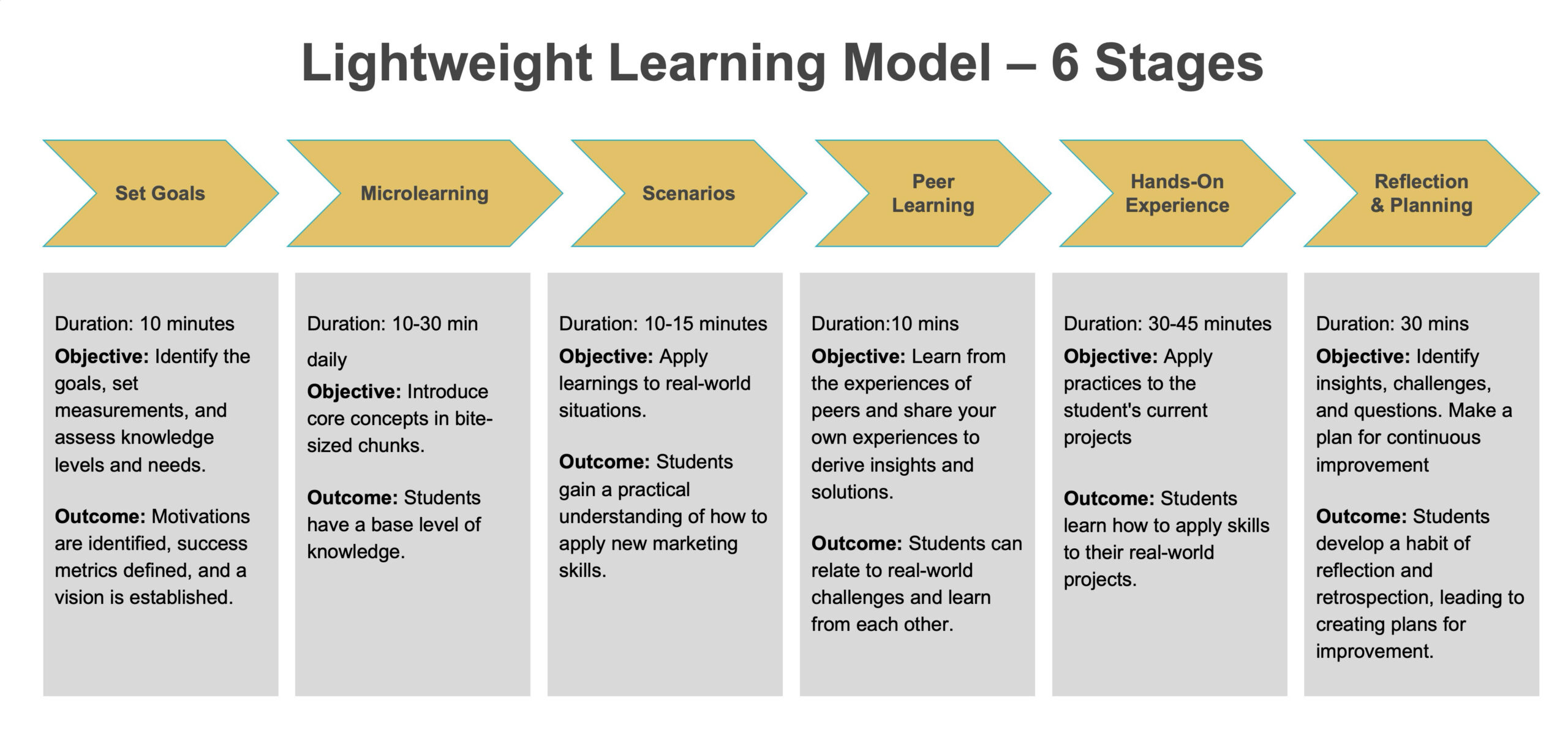
What will the future of work be in 2030? What about 2050? How will workplace productivity be impacted?
While it’s difficult to predict the future, it’s clear that the landscape of work is poised to undergo transformative shifts influenced by rapidly evolving technologies, demographic changes, and changing business practices. Workplace productivity will also be impacted, with promises of making marketers more effective and efficient.
For marketing leaders, understanding and anticipating these trends and preparing for them is critical for maximizing the capabilities of their teams and maintaining their own job security.
The Impact of AI on Marketing
In an interview earlier this year, Sam Altman, the CEO of OpenAI, described what he says will be the impact of AI (more specifically AGI or Artificial General Intelligence) on the future of work in marketing:
“95% of what marketers use agencies, strategists, and creative professionals for today will easily, nearly instantly and at almost no cost be handled by the AI — and the AI will likely be able to test the creative against real or synthetic customer focus groups for predicting results and optimizing. Again, all free, instant, and nearly perfect. Images, videos, campaign ideas? No problem.”
When asked about the timeline for this, Altman said “5 years, give or take, maybe slightly longer.”
Whatever the timeline, AI will have an almost incalculable impact on the future of work in marketing, much like the Internet has had an incalculable impact over the last thirty years.
We can’t really predict the details of AI’s impact, so how do we prepare for it?
How to Prepare for the Impact of AI on Marketing
Automate Routine Work – AI is great for automating routine work. For example, once a blog post is created, it has to be posted to multiple social media channels, linked to from a community site and perhaps turned into a video for your YouTube or TikTok channel. All of this can be automated by AI.
Use AI as an Intelligent Assistant – AI will not likely replace human creativity in the next thirty years, but it can assist human creativity if used in the right way. Instead of using AI to write your next blog, outline the blog and then ask ChatGPT what you might have forgotten and how to improve the outline. Use Perplexity for researching topics, particularly those that would benefit from scientific or academic research. Create a custom AI assistant within ChatGPT (learn how at this free course).
Re-Evaluate Your Marketing Tech Stack – AI will be embedded in almost every tool we use in our martech stack. Some tools will do a better job than others. Re-evaluate your marketing tech stack in light of how the tools you use today embed AI and whether new entrants do a better job taking advantage of AI than your existing tools.
Remote and Hybrid Work
Remote and Hybrid work models are here to stay. According to a 2023 Gallup study, 80% of remote-capable employees are now working in exclusively remote or hybrid arrangements.

If you look at the preference data, 94% of employees would prefer exclusively remote or hybrid work. What does this mean for marketers?
How to Take Advantage of Remote/Hybrid Work Models
Improve Productivity When Working Remotely – One study recently found workers to be 13% more productive at home, while another study by Stanford University found fully remote work about 10% less productive than fully in-person work. But both of these studies indicate that there is a wide variance in individual productivity in remote environments and that those workers who embrace productivity techniques adapted to working remotely see the greatest productivity and the greatest satisfaction with remote/hybrid work.
Increase communication and collaboration in remote and hybrid environments – Working exclusively or mostly remotely presents challenges. Workers don’t have as many opportunities to engage in informal communication, which can often lead to new observations and the building of trust. This is one of the reasons that the hybrid approach is so popular. Workers can use their in-person days to build relationships and informal networks, as well as engage in informal communication while reserving their at-home days for uninterrupted deep work. Workers should also focus on increasing communication and collaboration in hybrid and remote environments using visual management tools like digital Kanban boards.
Job Displacement and Skill Mismatch
A recent McKinsey study on the future of work predicts that 1 in 16 workers will have to switch occupations by 2030. This will be due to job displacement and skill mismatch. We’re also seeing the rise in the use of fractional positions, such as fractional CMOs. Companies seeking to save money are laying off Agile coaches, for example, and then hiring them back part-time on reduced salaries and without benefits.
How to Prepare for Job Displacement and Skills Mismatch
Skill Acquisition: In an era where job roles and required competencies evolve quickly, proactive investment in skills development is essential. Rather than waiting for the threat of job elimination or layoffs due to skill mismatches with organizational needs, embrace a philosophy of continuous learning. This approach not only secures your current position but also enhances your adaptability and value in the changing job market.
Check Out Our Latest Skill Acquisition Courses
Personal Branding: In today’s job market, organizational loyalty to employees is diminishing. It is increasingly important for individuals to cultivate their own brand. This might mean stepping into self-employment, aligning with consultancies, or engaging with fractional employment opportunities as alternatives to traditional, long-term company roles. Developing a robust personal brand allows you to navigate and thrive in this shifting landscape, offering greater control over your career direction and greater opportunities.
Ambient Learning
Ambient learning is an approach that integrates learning into the learner’s everyday environment and activities in an unobtrusive and seamless manner. Rather than take time out of work to attend “training,” ambient learners watch short videos or read short lessons that they can apply immediately in their work environment. They learn by doing, improving in small increments over time rather than attending multi-day training events. Ambient learning is just enough just-in-time learning.
How to Take Advantage of Ambient Learning
Ambient Learning:To apply ambient learning at work, look for materials that are directly related to the challenges that you face at work. Instead of “cert-chasing” (building up a long list of certifications), look for training that you can use immediately in your job.
Model your learning at work after Do It Yourself (DIY) learning from YouTube. When homeowners are looking to repair a leaky toilet, they search YouTube for the specific challenge or task, watch a short video, and apply their newfound knowledge immediately. They don’t look for courses to become certified plumbers.
This DIY model and ambient learning have been the inspiration behind our Lightweight Learning Model.

Final Thoughts
While the details of the future of work are unknown, we can examine particular trends and prepare for their impact.
These trends include the impact of artificial intelligence (AI), remote/hybrid work models, and the necessity for continual skill development and personal branding. By 2030 and beyond, remote and hybrid work environments will become the norm, with employees significantly preferring these flexible arrangements. This shift necessitates enhanced productivity and improved communication tools, such as digital Kanban boards, to foster effective collaboration and trust-building in less conventional work settings.
Moreover, AI is set to revolutionize marketing practices by automating routine tasks and serving as an intelligent assistant for many of the marketing activities that we do today. Marketers will need to re-evaluate their marketing tech stacks to integrate AI effectively and stay competitive.
It’s also important to anticipate job displacement and skill mismatches due to technological advancements and changing business needs. Strategies like embracing ambient learning, which integrates learning seamlessly into daily activities, and building a strong personal brand are recommended to navigate these challenges and secure a resilient career path in an evolving job market.

